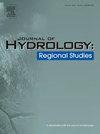Rainfall and streamflow variability in North Benin, West Africa, and its multiscale association with climate teleconnections
IF 4.7
2区 地球科学
Q1 WATER RESOURCES
引用次数: 0
Abstract
Study region
Three tributaries of the Niger River, covering 48,000 km² in northern Benin, West Africa.
Study focus
Understanding rainfall and streamflow variability in a warming world is crucial for drought-prone West Africa, whose economy relies heavily on rain-fed agriculture. This study explores past changes (1970–2020) in catchment rainfall and streamflow and their association with climate teleconnections.
New hydrological insights for the region
We find consistent rainfall patterns across the three catchments, with a recovery from the 1970s-1980s droughts starting in the 1990s. Total rainfall has increased significantly driven by more rainy days, although the wet day rainfall amount has decreased. These results can be summarized as ‘increased total rainfall, but less intense and more variable in space’. More rain, however, does not mean that the drought situation is alleviated, as high interannual and decadal variability persists. Wavelet coherence reveals that rainfall and streamflow variability are modulated by the climate teleconnections ENSO, AMO, and IOD. For rainfall, we find a tendency of a shift from lower-frequency coherence (4–10 years) in earlier decades to higher-frequency coherence (1–3 years) in recent decades. These patterns are less pronounced for streamflow due to indirect climate influences. Unlike many African studies relying on model simulations, these findings are based on quality-checked, dense station data networks, essential for understanding local climate impacts, water management, and early warning systems.
西非贝宁北部的降雨和流量变率及其与气候遥相关的多尺度关联
研究区域尼日尔河的三条支流,在西非贝宁北部覆盖48,000 平方公里。研究重点:了解全球变暖中的降雨和河流变化对容易干旱的西非至关重要,西非的经济严重依赖雨养农业。本研究探讨了流域降雨和径流的过去变化(1970-2020年)及其与气候遥相关的关系。我们发现三个流域的降雨模式一致,从20世纪90年代开始,从20世纪70年代至80年代的干旱中恢复过来。由于降雨日数增加,总降雨量显著增加,但湿日降雨量有所减少。这些结果可以概括为“总降雨量增加,但强度减少,空间变化更大”。然而,更多的雨水并不意味着干旱情况得到缓解,因为年际和年代际变化仍然很大。小波相干性表明,降雨和径流变率受到气候遥相关ENSO、AMO和IOD的调制。对于降雨,我们发现近几十年的趋势是从早期的低频相干性(4-10年)向高频相干性(1-3年)转变。由于气候的间接影响,这些模式在水流方面不太明显。与许多依赖模型模拟的非洲研究不同,这些发现是基于经过质量检查的密集站点数据网络,这对于了解当地气候影响、水资源管理和早期预警系统至关重要。
本文章由计算机程序翻译,如有差异,请以英文原文为准。
求助全文
约1分钟内获得全文
求助全文
来源期刊

Journal of Hydrology-Regional Studies
Earth and Planetary Sciences-Earth and Planetary Sciences (miscellaneous)
CiteScore
6.70
自引率
8.50%
发文量
284
审稿时长
60 days
期刊介绍:
Journal of Hydrology: Regional Studies publishes original research papers enhancing the science of hydrology and aiming at region-specific problems, past and future conditions, analysis, review and solutions. The journal particularly welcomes research papers that deliver new insights into region-specific hydrological processes and responses to changing conditions, as well as contributions that incorporate interdisciplinarity and translational science.
 求助内容:
求助内容: 应助结果提醒方式:
应助结果提醒方式:


